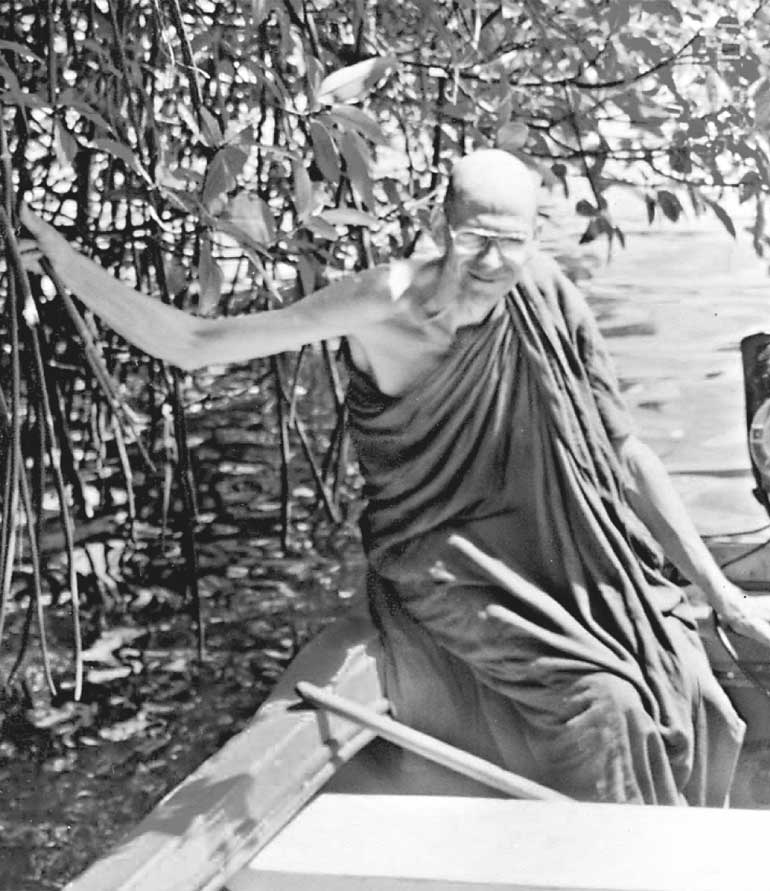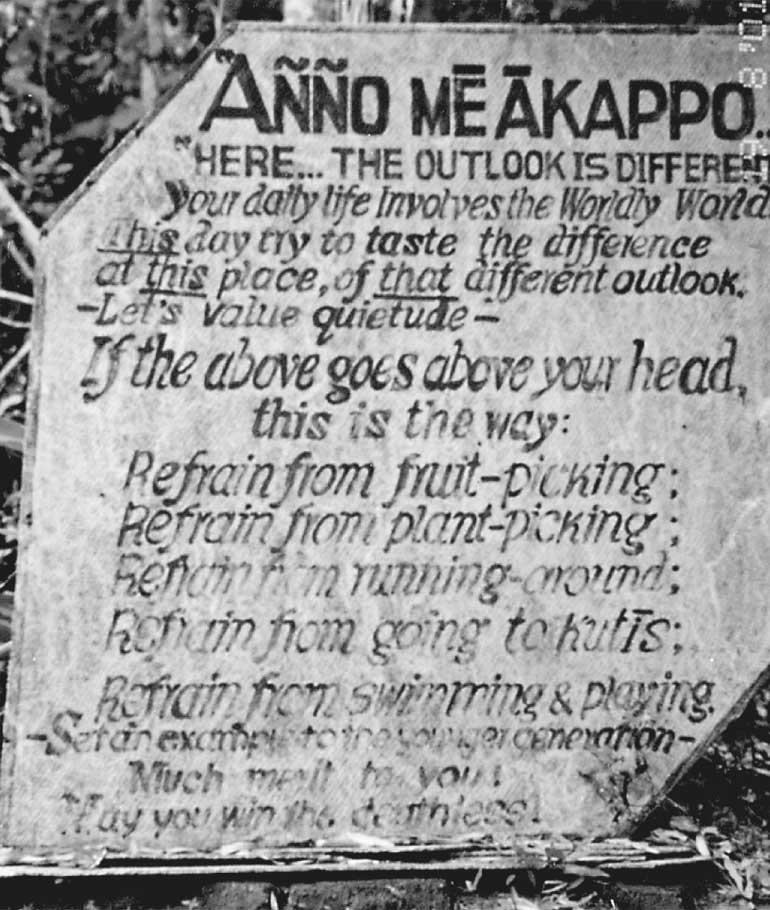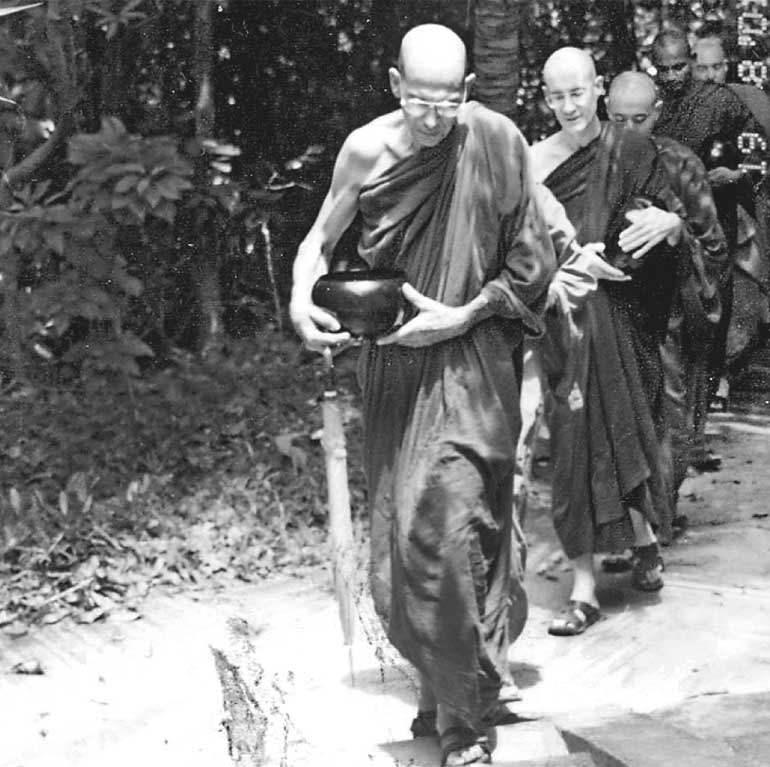Monday Feb 24, 2025
Monday Feb 24, 2025
Saturday, 6 February 2016 02:51 - - {{hitsCtrl.values.hits}}
By D.C. Ranatunga
Glancing through the pages of an Australian publication on the early days of Buddhism in Australia, I came across references to the highly respected German scholar monk, Venerable Nyanatiloka Mahathera who founded the Island Hermitage at Dodanduwa in South Sri Lanka.
World War I had started in Europe. Britain, a major partner of the Allies started hunting for Germans in the colonies of the British Empire. As they were caught they were jailed in different countries in the Empire.
The revered Mahathera along with four other German monks and two lay students were taken into custody and dispatched to Australia in early August 1915 as wartime internees. After their arrival in Sydney by ship they were sent to the Holdsworthy Concentration Camp at Liverpool. The others were the Theras Vappo, Mahanama, Kondanna and Vimala. There were 300 other Germans who were sent to the camp.
 Monk and boat
Monk and boat
Paul Croucher, the author of the book titled ‘A History of Buddhism in Australia 1848-1988’ quotes an observer’s description of the treatment the monks at the camp thus: “The Buddhist priests, being dressed in yellow and brown robes, were the subjects of considerable curiosity and hilarity, and immediately they arrived they were christened by the internees as canaries, and for days afterwards, whenever these priests appeared, whistling in imitation of canaries was the order of the day…They were extremely easy to feed and clothe, as they would not accept the ordinary articles of issue, neither would they requisition for any blankets, and for pillows they asked permission to procure large stones from outside the compound, so that they might rest their heads on them at night. Later, however, the majority of their religious sect, due perhaps to the ridicule of their fellow-countrymen, forsook their religion, were clothed in the orthodox trousers, and ate three good square meals a day.”
Croucher adds that the taunting and the cold seemed to have taken their toll and only Ven. Nyanatiloka and Ven. Vappa had remained in robes. He quotes an Italian who remembered him as being ‘corpulent, conversational and approachable….always scouting the compound for possible converts’. Ven. Vappo, on the other hand, ‘stonily ignored’ his adversaries, leaving them ‘frustrated and often shamed’.
 Notice
Notice
After some time, the monks had been moved to more congenial accommodation at Trial Bay, north of Newcastle. Here Ven. Nyanatiloka had a small hut built on the beachfront where he had been left undisturbed to do his writing. He had been allowed to leave for Hawaii in November 1916. According to Croucher, soon after he had got a teaching job at Tokyo University and eventually returned to Sri Lanka in 1926. Meanwhile, Ven. Vappo had remained in Australia until the end of the war in 1918.
Ven. Nyanatiloka’s links with Sri Lanka dates back to 1903 when he briefly visited before proceeding to Burma (now Myanmar) to get ordained. He was then 25. Returning to Europe after a few years he looked round to set up a monastery but eventually came to Sri Lanka in April 1911 to look for a suitable place.
While staying in Galle he chose the snake-infested abandoned island in the lagoon of Dodanduwa as a suitable place to meditate undisturbed, and set up a hermitage in July 1911. A Swiss supporter, Monsieur Rodolphe-Adrien Bergier who had set up a Buddhist hermitage in Lausanne where Ven. Nyhanatiloka had spent some time, bought the island from its Burgher owner and donated to the Mahathera.
The monk got five simple wooden huts built for the monks. According to Wikipedia, Ven. Nyanatiloka accepted the son of the chieftain of the Rodiya clan – considered as ‘untouchables’ at the time – to be ordained and named the ‘samanera’ Nyanaloka. He was to succeed as the abbot of the Island Hermitage after Ven. Nyanatiloka passed away in 1957.
Due to his writings Ven. Nyanatiloka was well known among the Europeans and those interested in donning a robe or seek the Mahathera’s guidance to meditate started coming to the Island Hermitage.
 On pindapatha
On pindapatha
On his return to Sri Lanka in 1926, he found the Island Hermitage totally neglected and he had to clear up the place and rebuild the ‘kutis’. The place started to flourish once again and became a popular destination for foreign dignitaries to visit for meditation retreats. Many foreigners came over to get ordained under Ven. Nyanatiloka. Most of them were Germans. Among them was Ven. Nyanaponika who got ordained in 1936. He was to become an eminent scholar like the teacher. According to him, Ven. Nyanatiloka had always carried with him unpleasant memories of the harsh treatment in the camp in Sydney.
When World War II broke out in 1939, the German monks including Ven. Nyanatiloka were again interned – first at Diyatalawa and later at Dehradun in India. They returned to the Island Hermitage in 1947. It was soon the popular haven for meditators once again. The visitors were mainly foreigners.
Bhikkhu Bodhi, the world-renowned American monk who was actively involved with the Buddhist Publication Society (BPS) in Kandy for many years, writes that Ven. Nyanatiloka combined instructions in Dhamma with lessons in Pali, which he insisted all his pupils learn. His standard course of instruction lasted between six and nine months. Thereafter he left his pupils to pursue their Dhamma studies and meditation practice on their own according to their personal inclination while he himself was always prepared to answer their questions and to provide advice and guidance. Meanwhile, he wrote a large number of books including translations of Pali texts to German.
Both Ven. Nyanatiloka and Ven. Nyanaponika were made distinguished citizens of Sri Lanka, their adopted homeland in early 1951. The Mahathera was offered a hermitage in Kandy at the Udawattakele Forest Reserve in the same year. He accepted it since he felt that a cooler climate would be more suitable for him in his advanced age.
His health gradually began to deteriorate and he moved to Colombo where he breathed his last on 28 May 1957. He was 79 years old. A State funeral was accorded to him at the Independence Square with Prime Minister S.W.R.D. Bandaranaike and a large number of religious and lay dignitaries present.
I remember visiting the Island Hermitage several years ago when a European monk residing there came to pick us up in a boat which he paddled. As we stepped on to the island, we spotted a notice which read:
Here the outlook is different
Your daily life involves the worldly world. This day try to taste the difference at this place of that different outlook.
Let’s value quietude.
If the above goes above your head, this is the way:
Refrain from fruit-picking;
Refrain from plant-picking;
Refrain from running round;
Refrain from going to kutis;
Refrain from swimming and playing;
Set an example to the younger generation.
Much merit to you!
May you win the deathless!
A simple thought provoking message.
As the mid-day alms time approached, resident monks came on ‘pindapatha’ walking quietly passing the rich and lush green vegetation carrying their alms-bowls.
We went about the enjoying the serenity of a solitary island where monks find pace and solace.
Discover Kapruka, the leading online shopping platform in Sri Lanka, where you can conveniently send Gifts and Flowers to your loved ones for any event including Valentine ’s Day. Explore a wide range of popular Shopping Categories on Kapruka, including Toys, Groceries, Electronics, Birthday Cakes, Fruits, Chocolates, Flower Bouquets, Clothing, Watches, Lingerie, Gift Sets and Jewellery. Also if you’re interested in selling with Kapruka, Partner Central by Kapruka is the best solution to start with. Moreover, through Kapruka Global Shop, you can also enjoy the convenience of purchasing products from renowned platforms like Amazon and eBay and have them delivered to Sri Lanka.
Discover Kapruka, the leading online shopping platform in Sri Lanka, where you can conveniently send Gifts and Flowers to your loved ones for any event including Valentine ’s Day. Explore a wide range of popular Shopping Categories on Kapruka, including Toys, Groceries, Electronics, Birthday Cakes, Fruits, Chocolates, Flower Bouquets, Clothing, Watches, Lingerie, Gift Sets and Jewellery. Also if you’re interested in selling with Kapruka, Partner Central by Kapruka is the best solution to start with. Moreover, through Kapruka Global Shop, you can also enjoy the convenience of purchasing products from renowned platforms like Amazon and eBay and have them delivered to Sri Lanka.